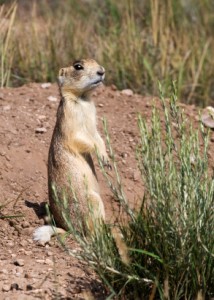 On this page, we deal with these issues related to climate change impacts on Manitoba grasslands:
On this page, we deal with these issues related to climate change impacts on Manitoba grasslands:
Click a link in the list above to jump to that topic on this page.
Grasslands
Grasslands are the most endangered habitat in Manitoba. Less than 1% of Manitoba’s original 6,000 square kilometers of tall-grass prairie remain. Climate change may expand existing grasslands as the average global temperature climbs. But will it help or hinder the plants and animals that call these rare habitats home?
General Circulation Models (complex computer programs that predict changes in Earth’s climate) predict a variety of climate impacts for southern Manitoba as greenhouse gases trap more heat in the atmosphere. These impacts include:
- higher summer temperatures
- increased rates of evaporation
- less summer rain
- decreased soil moisture
- an increase in the frequency and severity of droughts
These combined impacts are projected to press the southern boundary of the boreal forest north between 150 and 200 km. Aspen Parkland forest will expand northwards, and grassland habitat could double. Unfortunately, while the weather might call for more grass, the hard realities of climate change suggest that there will be very little real gain for many embattled grassland species.
Prairie wetlands
Among the hardest hit will be those species that rely on prairie wetlands. The prairie pothole region of North America is a nursery to 50 – 80% of North America’s waterfowl.
Hotter weather and less rain means that these little duck factories will disappear as evaporation empties them and runoff fails to recharge aquifers that sustain them. This could lead to an almost 50% reduction in breeding waterfowl numbers.
The loss of prairie wetlands spells doom for more than just ducks. Other wetland species such as muskrats, painted turtles, frogs, redwing and yellow-headed blackbirds and a diversity of aquatic invertebrates will also be out of a home.
Wildlife
The ranges of most grassland birds will likely shift northward into areas once occupied by forest.
However, unless all species (birds and plants) shift together at the same rate (an unlikely prospect) displaced birds will find themselves in the equivalent of an empty house in the wrong neighbourhood. No furniture, no food – just space they are not designed to fill. According to scientists, this is a likely scenario for at least two grassland birds. Sprague’s Pipit and McCowan’s Longspur may face extinction if climate change predictions come true.
The fate of other animals is more difficult to pinpoint. Only a few mathematical models have been developed for wildlife responses to climate change, and none of them deal specifically with the flora and fauna of the northern Great Plains. There is scant information available on the lives of individual species. Even less known of the ecological relationships between animals, plants and current patterns of sun, wind and water.
Past experiences
According to Douglas Johnson of the Northern Prairie Wildlife Research Centre, the past holds a clue to the future of grassland residents under climate change conditions.
Historical changes in temperature or precipitation led to huge shifts in the distribution of many grassland bird species within one or two years. But this type of upheaval took place when everything else remained unchanged — when human activities hadn’t fragmented, disturbed and introduced exotic competitors to the scene.
For grassland animals, climate change appears to add insult to injury. One of the most endangered habitats already in Canada – along with its wetlands, endangered spaces unto themselves – existing grasslands will become uncomfortably hot and arid for space-strapped prairie plants and critters. “New” grasslands that are projected to appear as heat stressed forests retreat to the north will be a poor substitute for the place where the bison once roamed.




